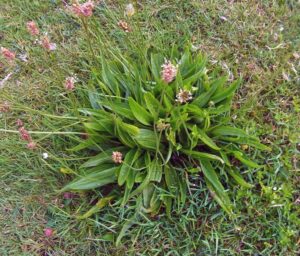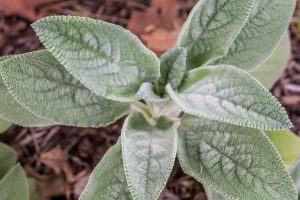
Approx. Reading time: About 38 Minutes

Introduction
A Comprehensive Guide to Foraging and Utilizing this Versatile Plant
Amaranth, a versatile and nutritious plant, has been a staple in diets across the world for centuries. Known for its vibrant hues and rich nutrient profile, Amaranth is more than just a leafy green—it is a treasure trove of culinary, medicinal, and magical potential. In this guide, we will explore everything you need to know about foraging Amaranth, including its variants, identification tips, habits, uses, and safety considerations.

What is Amaranth?
Amaranth, a botanical marvel within the Amaranthaceae family, represents a genus of plants that has captured the imagination and culinary preferences of cultures worldwide. Revered for its vibrant colors and rich history, Amaranth is much more than just a plant—it is a symbol of resilience, adaptability, and nourishment. Originating from the Americas, particularly Central and South America, Amaranth has been a staple in indigenous diets for thousands of years, celebrated not only for its aesthetic appeal but also for its incredible nutritional value.
The name “Amaranth” itself is derived from the Greek word “amarantos,” meaning “unfading,” which is fitting given the plant’s enduring presence across continents and centuries. The genus encompasses a wide variety of species, each known for its striking foliage, which can range in color from deep red to brilliant, purple, and lush green. These vibrant hues are not only visually captivating but also indicate the plant’s rich content of phytonutrients, antioxidants, and vitamins.
Amaranth is uniquely versatile, offering both edible leaves and seeds that have been integral to traditional diets and continue to be embraced in modern culinary practices. The young leaves of Amaranth are tender and flavorful, making them a popular choice for salads, sautés, and soups. As the plant matures, its leaves can still be enjoyed cooked, offering a slightly nutty and earthy taste.
In addition to its leaves, Amaranth is also cultivated for its tiny, nutrient-dense seeds. These seeds, which are often referred to as pseudocereals, are gluten-free and rich in protein, fiber, and essential minerals like calcium, magnesium, and iron. Unlike many other grains, Amaranth seeds contain a complete protein, providing all the essential amino acids the human body needs. This makes Amaranth a vital food source in regions where access to diverse protein sources may be limited.
The adaptability of Amaranth is another of its defining characteristics. It thrives in a wide range of climates and soil conditions, from the high altitudes of the Andes to the plains of Africa and Asia. This resilience has allowed Amaranth to spread globally, where it has been naturalized in many parts of the world, including North America, Europe, Africa, and Asia. In many cultures, Amaranth is not only a dietary staple but also a symbol of agricultural sustainability, offering a reliable crop that can withstand harsh growing conditions and provide nourishment even in times of scarcity.
Amaranth’s potential as both a leafy green and a grain crop makes it a unique and valuable addition to any garden or foraging expedition. Whether you are harvesting the tender leaves for a fresh salad, cooking the mature greens in a hearty stew, or collecting the seeds to grind into flour or pop like popcorn, Amaranth offers endless possibilities for culinary creativity and nutritional enrichment.
Amaranth is a plant of great cultural, nutritional, and ecological significance. Its striking appearance, coupled with its adaptability and health benefits, has made it a cherished crop throughout history and a continuing source of inspiration for those seeking to connect with nature through foraging, gardening, and cooking.
Variants of Amaranth
1. Amaranthus cruentus (Red Amaranth): Known for its striking red leaves and vibrant seed heads, Red Amaranth is commonly used in cooking and traditional medicine. It is valued for its aesthetic appeal and nutritional benefits.
2. Amaranthus retroflexus (Redroot Pigweed): This variety features green to reddish stems and a broad range of leaf shapes. It is often found in gardens and disturbed areas and is known for its adaptability.
3. Amaranthus hypochondriacus (Prince’s Feather): Recognizable by its tall, upright growth and bright red or purple plumes, Prince’s Feather is grown both for its ornamental qualities and its edible seeds.
4. Amaranthus dubius (Slender Amaranth): Characterized by its slender stems and leaves, this variant is commonly used in tropical and subtropical regions.
5. Amaranthus caudatus (Love-Lies-Bleeding): This variant is noted for its long, drooping clusters of red flowers and is used both decoratively and in cooking.
How to Identify Amaranthus cruentus (Red Amaranth)
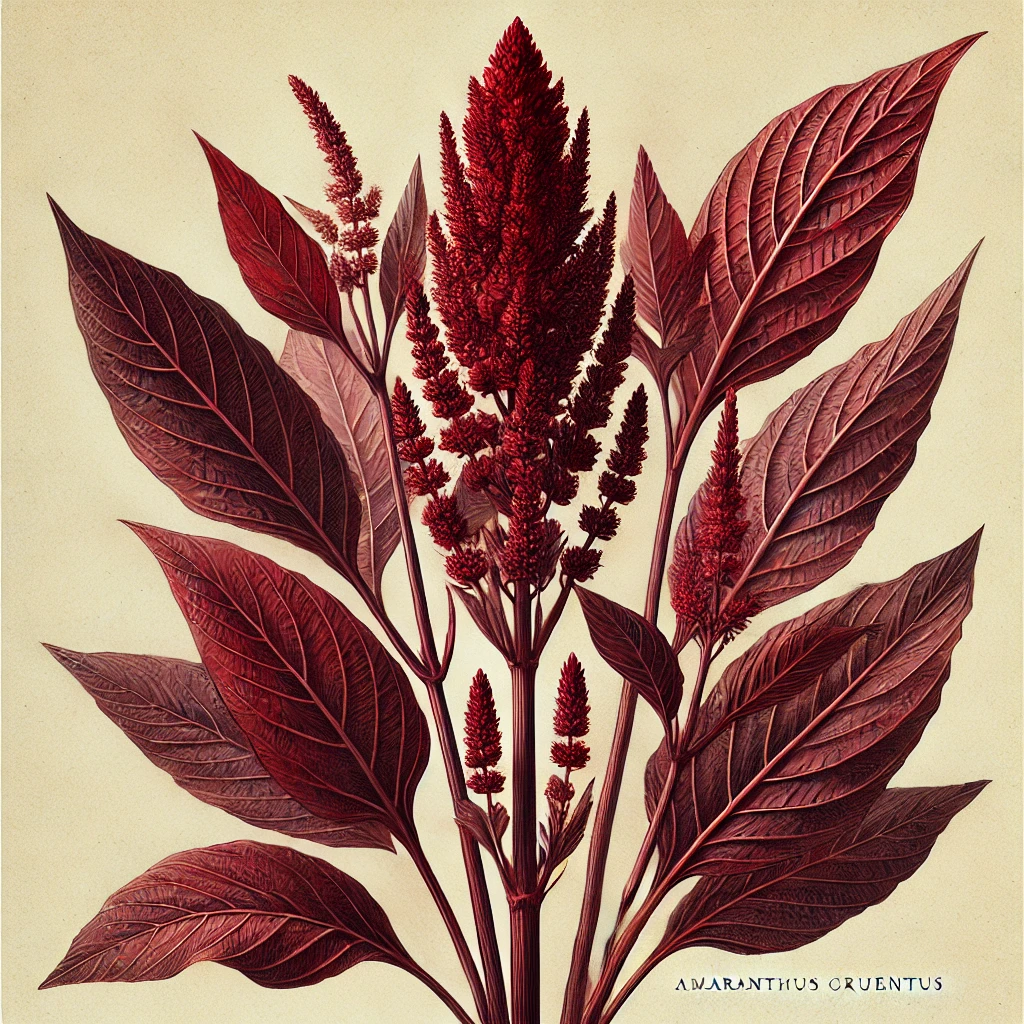
Amaranthus cruentus, commonly known as Red Amaranth, is one of the most visually striking and nutritionally rich species within the Amaranth genus. Its vibrant colors and unique features make it easy to identify in the wild or in cultivated gardens. Below are the key identifying characteristics of Red Amaranth, including details on its leaf shape and color, stem color, flower structure, and seed heads.
Leaf Shape and Color
- Shape: The leaves of Amaranthus cruentus are broad and lance-shaped with a slightly pointed tip. They have a smooth, glossy surface and may display subtle veining.
- Color: As the name suggests, the leaves are typically a deep, rich red or burgundy color, although they can also exhibit shades of purple or green, depending on the growing conditions. Young leaves often have a more intense color, while mature leaves may develop a mix of red and green hues.
Stem Color
- Color: The stems of Red Amaranth are another distinguishing feature, often highlighting a striking red or burgundy hue that complements the color of the leaves. The stems are usually sturdy and upright, providing strong support for the large foliage and flower structures.
- Texture: The stem surface can be slightly rough to the touch and may have a ribbed texture. The red coloration of the stems can sometimes extend to the leaf petioles (the stalks that attach the leaves to the stem), enhancing the plant’s overall visual appeal.
Flower Structure
- Inflorescence: Red Amaranth produces large, dense flower clusters, known as inflorescences, which can grow in upright spikes or sometimes droop slightly due to their weight. The inflorescences are made up of tiny, densely packed flowers.
- Color: The flowers themselves are usually red to burgundy, matching the color of the leaves and stems, though they can sometimes appear more pinkish or purple. The vibrant flower spikes add to the plant’s ornamental value and make it easily identifiable during its blooming period.
- Season: Red Amaranth typically flowers in mid to late summer, depending on the climate, and the inflorescences can persist well into the fall.
Seed Heads
- Structure: After the flowers have bloomed, they give way to small, round seed heads. These seed heads are packed tightly within the inflorescences and can range in color from red to dark brown or black.
- Seeds: The seeds of Red Amaranth are tiny, often appearing black or dark brown. They are glossy and can be easily harvested by shaking or rubbing the mature flower spikes. These seeds are highly nutritious and can be used in a variety of culinary applications.
Additional Tips for Identification
- Growth Habit: Red Amaranth is typically a tall plant, often reaching heights of 4 to 6 feet, depending on growing conditions. Its upright growth habit and large, colorful leaves make it stand out in gardens and wild settings.
- Location: This species of Amaranth is often found in gardens, cultivated fields, or wild areas with rich, well-drained soil. It prefers full sun but can also tolerate partial shade.
By focusing on these key identifying features—leaf shape and color, stem color, flower structure, and seed heads—you can confidently identify Amaranthus cruentus (Red Amaranth) in the wild or in cultivated settings. Its vibrant red hues and distinctive growth patterns make it a memorable plant that is both beautiful and nutritious.
How to Identify Amaranthus retroflexus (Redroot Pigweed)

Amaranthus retroflexus, commonly known as Redroot Pigweed, is a widespread and hardy species within the Amaranth family. It is known for its resilience and adaptability, often thriving in disturbed soils such as agricultural fields, gardens, and roadsides. Identifying Redroot Pigweed requires careful observation of its distinct characteristics, including leaf shape and color, stem color, flower structure, and seed heads. Below are the key features to look for when identifying this common plant.
Leaf Shape and Color
- Shape: The leaves of Redroot Pigweed are typically oval to lance-shaped, with a slightly wavy or smooth margin. They are broader near the base and taper to a rounded or slightly pointed tip.
- Color: The leaves are medium to dark green, with a dull surface. The underside of the leaves may be lighter in color and can sometimes exhibit a slight reddish hue, particularly in younger leaves or under certain environmental conditions.
Stem Color
- Color: The stems of Amaranthus retroflexus are usually green but can exhibit a reddish tinge, especially near the base of the plant. This reddish coloration is particularly prominent in young plants and gives the plant its common name, Redroot Pigweed.
- Texture: The stem is often thick and sturdy, with a rough, ridged texture. The reddish coloration can extend along the length of the stem, especially in mature plants.
Flower Structure
- Inflorescence: Redroot Pigweed produces dense, bristly flower clusters that form at the tips of the stems and in the leaf axils (where the leaves attach to the stem). These inflorescences are often elongated and have a spiky appearance.
- Color: The flowers themselves are small and greenish, blending in with the surrounding foliage. They are not particularly showy but can be identified by their dense, clustered arrangement.
- Season: Flowering typically occurs in late summer to early fall, depending on the region, and the flowers eventually give way to seed production as the season progresses.
Seed Heads
- Structure: After flowering, Redroot Pigweed produces small, round seed heads that develop within the bristly inflorescences. These seed heads are densely packed and can be difficult to see without close inspection.
- Seeds: The seeds of Redroot Pigweed are tiny, black, and shiny. They are enclosed within the bristly flower clusters and are released as the seed heads mature and dry out. These seeds are highly prolific, contributing to the plant’s reputation as a persistent weed in agricultural settings.
Additional Tips for Identification
- Growth Habit: Redroot Pigweed is typically an erect plant, growing between 1 to 6 feet tall, depending on environmental conditions. It has a branching growth habit, with stems often emerging from a central point near the base.
- Root System: The plant’s root system is notable for its reddish taproot, which can be a key identifying feature when pulling the plant from the ground. The taproot is thick and sturdy, anchoring the plant firmly in the soil.
- Location: Amaranthus retroflexus is commonly found in disturbed soils, such as gardens, crop fields, and roadsides. It thrives in full sun and can tolerate a wide range of soil types, making it a prevalent species in many areas.
By focusing on these key identifying features—leaf shape and color, stem color, flower structure, and seed heads—you can accurately identify Amaranthus retroflexus (Redroot Pigweed) in various environments. Its characteristic reddish taproot, dense flower clusters, and widespread presence make it a recognizable and notable member of the Amaranth family.
How to Identify Amaranthus hypochondriacus (Prince’s Feather)
Amaranthus hypochondriacus, commonly known as Prince’s Feather, is a striking and ornamental member of the Amaranth family. Known for its tall stature and vibrant, feathery flower spikes, Prince’s Feather is both a decorative plant and a valuable source of edible seeds. Below are the key identifying features to help you accurately identify Amaranthus hypochondriacus in the garden or wild, including its leaf shape and color, stem color, flower structure, and seed heads.
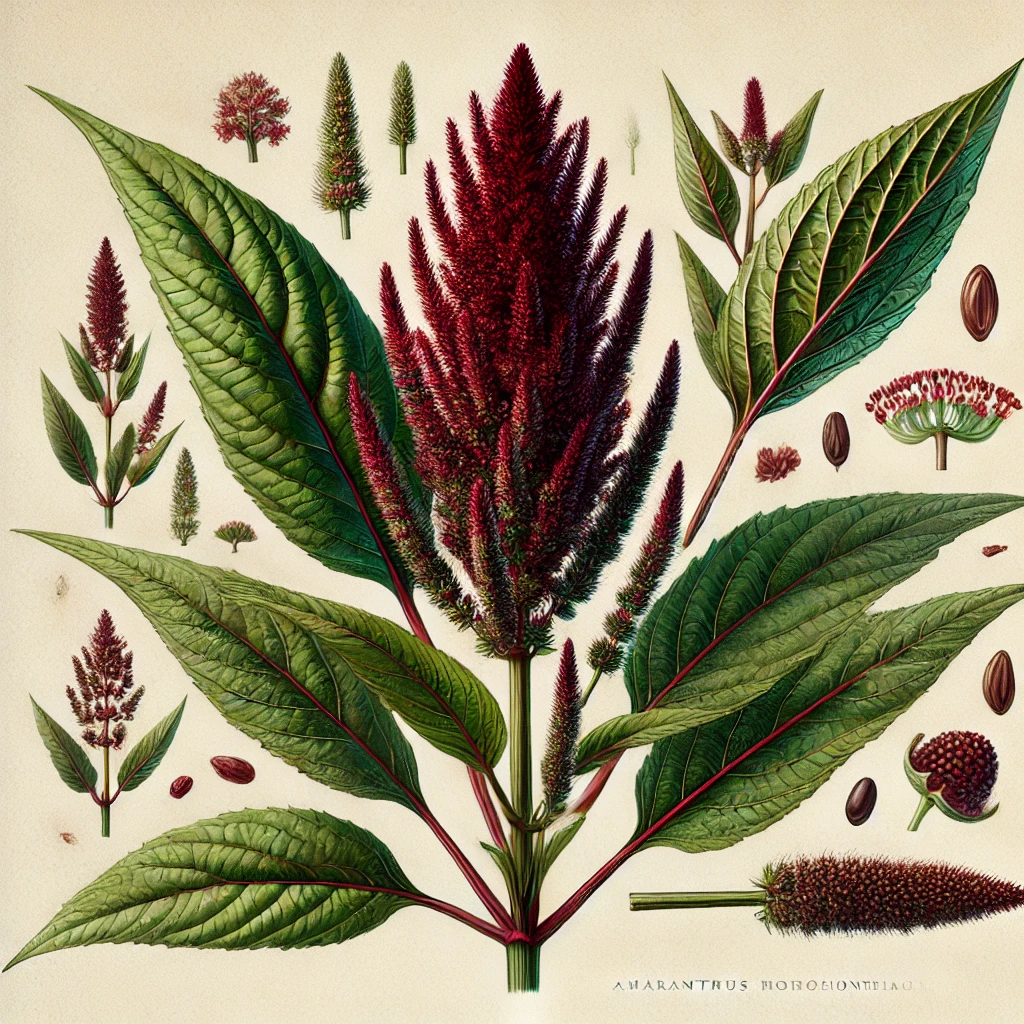
Leaf Shape and Color
- Shape: The leaves of Prince’s Feather are typically lance-shaped to oval, with a broad base that tapers to a pointed tip. The leaf margins are smooth, and the surface of the leaf is often slightly glossy, with prominent veins running through it.
- Color: The leaves are green, although they can sometimes display a reddish or purplish tint, particularly in younger plants or under certain growing conditions. This subtle coloration can add to the plant’s ornamental appeal, especially when contrasted with the vibrant flower spikes.
Stem Color
- Color: The stems of Amaranthus hypochondriacus are usually green but can also take on a reddish or purplish hue, particularly near the nodes (where the leaves attach to the stem). This coloration can extend along the entire stem, depending on the variety and environmental factors.
- Texture: The stem is smooth and sturdy, supporting the plant’s tall and upright growth habit. The stem’s thickness and rigidity are key to supporting the large, feathery flower spikes that give Prince’s Feather its name.
Flower Structure
- Inflorescence: One of the most distinctive features of Prince’s Feather is its large, feathery flower spikes, which can grow up to several feet in length. These inflorescences are dense and composed of numerous small flowers clustered together, giving them a plume-like appearance.
- Color: The flower spikes are typically deep red, burgundy, or magenta, though some varieties may have lighter pink or even golden-yellow inflorescences. The vibrant color of the flowers makes Prince’s Feather a popular choice for ornamental gardens.
- Season: Flowering typically occurs in mid to late summer, with the dramatic flower spikes lasting well into the fall. These flowers are not only beautiful but also attract pollinators, making the plant a valuable addition to any garden.
Seed Heads
- Structure: As the flowers mature, they give way to small seed heads hidden within the dense inflorescences. These seed heads are usually formed within the flower spikes and can be difficult to see without close inspection.
- Seeds: The seeds of Prince’s Feather are small, round, and typically dark brown to black. They are edible and have been used traditionally as a grain in various cultures. The seeds are easily harvested by shaking or rubbing the mature flower spikes, which release the tiny seeds.
Additional Tips for Identification
- Growth Habit: Prince’s Feather is a tall and robust plant, often reaching heights of 4 to 8 feet. Its upright growth habit, combined with its large, feathery flower spikes, makes it a commanding presence in any garden or natural setting.
- Location: This species is often found in cultivated gardens, ornamental landscapes, and sometimes in wild or semi-wild areas where it may have escaped cultivation. It prefers full sun and well-drained soil, thriving in warm climates but adaptable to a variety of conditions.
By focusing on these key identifying features—leaf shape and color, stem color, flower structure, and seed heads—you can confidently identify Amaranthus hypochondriacus (Prince’s Feather). Its tall stature, vibrant flower spikes, and rich coloration make it a distinctive and memorable plant that is as useful as it is beautiful. Whether growing in a garden or found in the wild, Prince’s Feather is sure to capture your attention with its striking appearance and versatile uses.
How to Identify Amaranthus dubius (Slender Amaranth)[JH4]

Amaranthus dubius, commonly known as Slender Amaranth, is a versatile and widely distributed species within the Amaranth family. This plant is frequently found in tropical and subtropical regions and is known for its edible leaves and seeds. Identifying Amaranthus dubius involves paying close attention to its characteristic leaf shape and color, stem color, flower structure, and seed heads. Below are the key features to help you recognize Slender Amaranth in various environments.
Leaf Shape and Color
- Shape: The leaves of Slender Amaranth are typically ovate to lance-shaped, with a broad base that tapers smoothly to a pointed tip. The leaves are relatively small compared to other Amaranth species, contributing to the plant’s slender appearance.
- Color: The leaves are green, though they can range from light to dark green depending on the plant’s age and growing conditions. The leaf surface is smooth, and the veins are usually not as prominent as in other Amaranth species. Young leaves tend to be more tender and brighter in color.
Stem Color
- Color: The stems of Amaranthus dubius are usually green but can also exhibit a reddish or purplish tint, especially at the base or where the leaves attach. This coloration may become more pronounced as the plant matures, though it is less vivid than in other Amaranth species like Red Amaranth or Prince’s Feather.
- Texture: The stem is slender, smooth, and can sometimes appear slightly glossy. Despite its thinner structure, the stem is strong enough to support the plant’s growth, which is typically upright and branching.
Flower Structure
- Inflorescence: Slender Amaranth produces small, clustered flower spikes that grow at the tips of the stems and in the leaf axils. These inflorescences are less dense and less showy compared to those of other Amaranth species, but they are still an important identifying feature.
- Color: The flowers are usually greenish to pale, blending in with the surrounding foliage. They are small and not particularly eye-catching, but their clustered arrangement in elongated spikes is a key characteristic.
- Season: Flowering occurs throughout the year in tropical climates, but in more temperate regions, it typically occurs in late spring to early fall.
Seed Heads
- Structure: After the flowers have bloomed, they produce small seed heads within the inflorescences. These seed heads are modest in size and less conspicuous compared to those of larger Amaranth species.
- Seeds: The seeds of Slender Amaranth are tiny, round, and typically black or dark brown. They are produced in abundance and are easily dispersed by wind or water, contributing to the plant’s widespread distribution.
Additional Tips for Identification
- Growth Habit: Amaranthus dubius is a smaller and more delicate plant compared to other Amaranth species, typically growing between 1 to 4 feet tall. Its slender stems and smaller leaves give it a more delicate appearance, which contrasts with the more robust growth habits of its relatives.
- Location: Slender Amaranth thrives in warm, tropical, and subtropical regions. It is commonly found in gardens, fields, roadsides, and other disturbed areas where the soil is rich and well-drained. It prefers full sun but can tolerate partial shade.
By focusing on these key identifying features—leaf shape and color, stem color, flower structure, and seed heads—you can accurately identify Amaranthus dubius (Slender Amaranth) in its natural habitat. Its slender appearance, modest inflorescences, and adaptability to various environments make it a unique and valuable member of the Amaranth family, especially in regions where it is cultivated for its edible leaves and seeds.
How to Identify Amaranthus caudatus (Love-Lies-Bleeding)
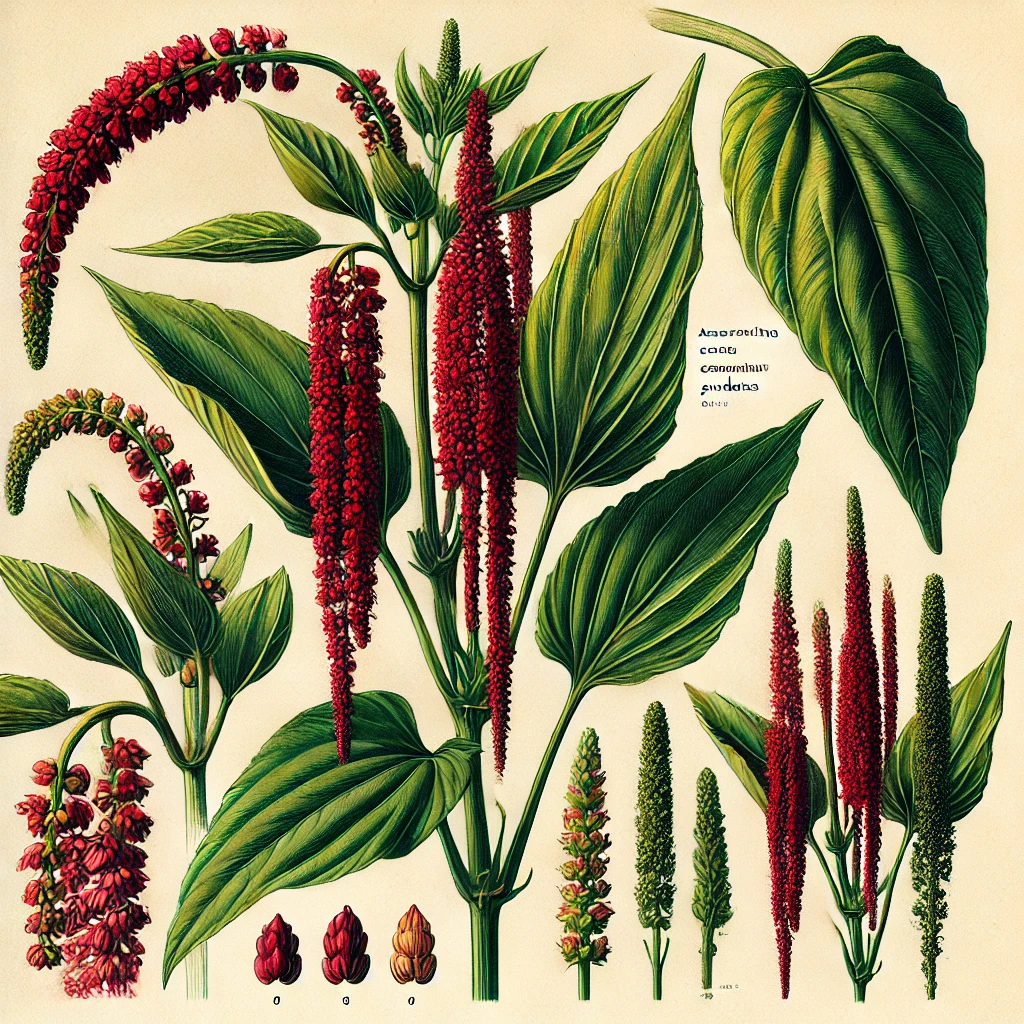
Amaranthus caudatus, commonly known as Love-Lies-Bleeding, is one of the most visually striking members of the Amaranth family. Known for its long, drooping clusters of vibrant red or magenta flowers, this plant is both an ornamental wonder and a valuable source of edible seeds. To accurately identify Love-Lies-Bleeding, focus on its key characteristics, including leaf shape and color, stem color, flower structure, and seed heads.
Leaf Shape and Color
- Shape: The leaves of Amaranthus caudatus are typically ovate to lance-shaped, with a broad base tapering to a pointed tip. They have a smooth margin and are often slightly curved or wavy along the edges.
- Color: The leaves are bright to deep green, though they can sometimes have a reddish or purplish tint, especially in younger plants or in certain growing conditions. The leaf surface is smooth, and the veins are slightly raised, giving the leaves a textured appearance.
Stem Color
- Color: The stems of Love-Lies-Bleeding are usually green but can range from green to reddish or purplish, particularly near the nodes where the leaves attach. The reddish stems are more common in mature plants and add to the plant’s ornamental appeal.
- Texture: The stems are strong and sturdy, capable of supporting the plant’s tall growth and heavy, pendulous flower clusters. The texture is smooth, with a slightly ribbed appearance.
Flower Structure
- Inflorescence: The most distinctive feature of Amaranthus caudatus is its dramatic flower structure. The plant produces long, drooping clusters of flowers, known as inflorescences, which can cascade several feet downwards. These inflorescences resemble ropes or tassels and are densely packed with tiny flowers.
- Color: The flowers are typically deep red, magenta, or burgundy, though some varieties may produce pink or greenish flowers. The vibrant color of the inflorescences is a hallmark of Love-Lies-Bleeding and makes it a popular choice for ornamental gardens.
- Season: Flowering usually occurs in mid to late summer, with the tassels often lasting well into the fall. The flowers are long-lasting and maintain their vibrant color even as they dry.
Seed Heads
- Structure: As the flowers mature, they give way to small seed heads embedded within the dense flower clusters. These seed heads are well hidden within the tassels and can be difficult to spot without close inspection.
- Seeds: The seeds of Love-Lies-Bleeding are tiny, round, and typically golden or black. They are highly nutritious and can be harvested by gently shaking or rubbing the mature flower clusters to release the seeds. These seeds have been used traditionally in various cultures as a grain.
Additional Tips for Identification
- Growth Habit: Amaranthus caudatus is a tall, upright plant that can reach heights of 3 to 8 feet, depending on growing conditions. Its most striking feature is the long, drooping flower tassels that make it stand out in any garden or wild setting.
- Location: Love-Lies-Bleeding is often cultivated in ornamental gardens due to its dramatic appearance, but it can also be found in wild or semi-wild areas where it may have escaped cultivation. It prefers full sun and well-drained soil, thriving in warm climates.
By focusing on these key identifying features—leaf shape and color, stem color, flower structure, and seed heads—you can confidently identify Amaranthus caudatus (Love-Lies-Bleeding). Its long, cascading flower tassels, vibrant colors, and tall stature make it one of the most recognizable and visually appealing members of the Amaranth family. Whether cultivated for its beauty or harvested for its seeds, Love-Lies-Bleeding is a plant that captures attention and admiration wherever it grows.
Habits of Amaranth
Amaranth is a dynamic and resilient annual plant, widely celebrated for its adaptability and vigorous growth. This versatile species, encompassing a variety of colorful and nutrient-rich plants, thrives in a range of environmental conditions, making it a favorite among gardeners, foragers, and farmers alike. Whether you are cultivating Amaranth in a well-tended garden or encountering it in the wild, understanding its growth habits and preferences can help you make the most of this remarkable plant.
Growth Characteristics
Amaranth is renowned for its rapid growth, often reaching impressive heights between 3 to 6 feet within a single growing season. Some species, like Amaranthus hypochondriacus (Prince’s Feather), can even surpass this height under optimal conditions, creating towering, vibrant displays. The plant’s upright and often branching structure supports large leaves and dense flower clusters, which are the hallmark of many Amaranth species.
The plant’s ability to thrive in a wide array of climates and soil conditions contributes to its persistence in both cultivated and wild areas. Amaranth’s hardy nature allows it to sprout vigorously in well-drained soils and sunny locations, quickly establishing itself and outcompeting less robust plants. This resilience is further enhanced by its prolific self-seeding behavior. Once established, Amaranth can reseed itself year after year, ensuring its continued presence in gardens, fields, and untamed landscapes.
Growing Conditions
Amaranth’s adaptability is one of its most remarkable traits, making it a versatile choice for a variety of growing environments. To maximize its growth and yield, however, certain conditions can be optimized:
- Climate: Amaranth thrives in warm climates, where it can take full advantage of the long growing season. It is particularly well-suited to temperate and tropical regions but is also capable of adapting to cooler environments. While it prefers temperatures between 70°F to 85°F (21°C to 29°C), Amaranth can endure a broader range of temperatures as long as it is not subjected to prolonged cold or frost, which can inhibit its growth.
- Soil: Amaranth grows best in well-drained, fertile soils with a slightly acidic to neutral pH, typically ranging from 6.0 to 7.5. While it can tolerate poorer soils, Amaranth truly flourishes in nutrient-rich conditions where organic matter is abundant. The plant’s deep root system allows it to access nutrients and moisture even in less-than-ideal soils, though heavy clay or overly compacted soils may impede its growth.
- Light: Amaranth is a sun-loving plant that thrives in full sun, where it can photosynthesize efficiently and grow rapidly. It requires at least 6 to 8 hours of direct sunlight per day to reach its full potential. However, Amaranth is also capable of tolerating partial shade, especially in hotter climates where some relief from the midday sun can prevent leaf scorching. In shaded areas, however, the plant may grow taller and spindlier as it reaches for light, potentially reducing its overall yield.
Resilience and Persistence
Amaranth’s resilience is one of the key factors behind its widespread cultivation and naturalization in various regions around the world. This plant is not only tolerant of a range of growing conditions but is also highly resistant to many common pests and diseases. Its robust nature allows it to thrive where other crops might struggle, making it a reliable choice for both home gardeners and larger agricultural operations.
Moreover, Amaranth’s self-seeding habit ensures that once it is introduced to an area, it is likely to return year after year. The seeds, small and numerous, are easily dispersed by wind, water, or human activity, allowing the plant to colonize new areas quickly. This can be a boon for gardeners looking for a low-maintenance crop, but it also means that Amaranth can become invasive if not managed carefully.
Medicinal Uses of Amaranth
Amaranth, a plant cherished across the globe for its vibrant colors and culinary versatility, is equally valued for its impressive medicinal properties. Both the leaves and seeds of Amaranth are packed with nutrients that offer a range of health benefits, making this ancient grain a powerful ally in promoting overall wellness. Let us delve deeper into the specific medicinal uses of Amaranth and how it can contribute to a healthier lifestyle.
Nutrient-Rich Superfood
Amaranth is often hailed as a nutrient-dense superfood, providing a rich source of essential vitamins, minerals, and macronutrients.
- Protein: Unlike most plant-based foods, Amaranth is a complete protein, meaning it contains all nine essential amino acids that the human body cannot produce on its own. This makes it an excellent dietary choice for vegetarians, vegans, and anyone looking to boost their protein intake from plant-based sources. The high protein content in Amaranth helps in muscle repair, immune function, and overall body maintenance.
- Vitamins: Amaranth leaves and seeds are abundant in vitamins such as Vitamin A, C, and folate. Vitamin A is crucial for maintaining healthy vision, immune function, and skin integrity. Vitamin C acts as a powerful antioxidant, protecting the body against free radicals, supporting immune health, and aiding in the absorption of iron. Folate, an essential B-vitamin, plays a vital role in DNA synthesis and repair, making it particularly important for pregnant women to prevent neural tube defects in the developing fetus.
- Minerals: Amaranth is a rich source of key minerals such as calcium, iron, and magnesium. Calcium is essential for strong bones and teeth, as well as for proper muscle function and nerve signaling. Iron is critical to produce hemoglobin, the protein in red blood cells that carries oxygen throughout the body. Magnesium supports a wide range of biochemical reactions in the body, including energy production, muscle and nerve function, and the regulation of blood pressure.
Incorporating Amaranth into your diet can help ensure that you meet your daily nutritional needs, supporting overall health and vitality.
Anti-Inflammatory Benefits
Amaranth has been recognized for its potential anti-inflammatory properties, which can play a significant role in managing and reducing chronic inflammation—a condition linked to numerous health issues such as heart disease, diabetes, and autoimmune disorders.
- Bioactive Compounds: Amaranth contains various bioactive compounds, including peptides and phytochemicals, which have been studied for their ability to modulate the body’s inflammatory response. These compounds can help reduce the production of inflammatory markers, potentially lowering the risk of chronic inflammatory conditions.
- Aiding in Recovery: For individuals experiencing inflammation-related conditions, such as arthritis or inflammatory bowel disease, incorporating Amaranth into their diet may offer supportive benefits. The anti-inflammatory properties of Amaranth can help alleviate symptoms such as pain, swelling, and discomfort, aiding in the overall management of these conditions.
Regular consumption of Amaranth, either as part of a balanced diet or in the form of supplements, can contribute to reducing inflammation and promoting long-term health.
Digestive Health and Gut Support
Amaranth’s high fiber content makes it an excellent food for supporting digestive health and maintaining a healthy gut microbiome.
- Fiber Content: Both the leaves and seeds of Amaranth are rich in dietary fiber, which is essential for healthy digestion. Fiber adds bulk to the stool, facilitating regular bowel movements and preventing constipation. It also helps to regulate blood sugar levels by slowing down the absorption of glucose, which can be particularly beneficial for individuals with diabetes or those at risk of developing the condition.
- Prebiotic Effects: The fiber in Amaranth also acts as a prebiotic, meaning it serves as food for the beneficial bacteria in the gut. A healthy gut microbiome is crucial for overall health, influencing everything from digestion and nutrient absorption to immune function and mental well-being. By promoting the growth of beneficial bacteria, Amaranth can help maintain a balanced gut environment and support overall digestive health.
- Gut-Healing Properties: In traditional medicine, Amaranth has been used to soothe the digestive tract and alleviate symptoms of gastrointestinal distress. The plant’s mucilaginous properties, particularly in the seeds, can help protect the lining of the gut, making it a useful remedy for conditions like gastritis, acid reflux, and irritable bowel syndrome (IBS).
Incorporating Amaranth into your diet can promote regular digestion, improve gut health, and contribute to a balanced and healthy digestive system.
Culinary Uses of Amaranth
Amaranth, with its rich history as a staple food in many cultures, continues to shine in modern kitchens thanks to its incredible versatility and nutritional value. Both the leaves and seeds of Amaranth can be used in a wide array of dishes, making it a valuable addition to any culinary repertoire. Below, we explore the diverse culinary applications of Amaranth, from fresh salads to hearty stews, highlighting how this ancient plant can enhance your meals.
Leafy Greens
Amaranth leaves, particularly when young and tender, are a delicious and nutritious addition to many dishes. These vibrant greens have a mild, slightly nutty flavor that complements a variety of other ingredients.
- Salads: Fresh, young Amaranth leaves can be used as a base for salads, providing a nutrient-dense alternative to traditional salad greens like lettuce or spinach. Their subtle flavor pairs well with a range of dressings, from light vinaigrettes to creamy options. You can combine them with other greens, fruits, nuts, and cheeses to create a well-rounded and flavorful salad. The leaves’ tender texture and slight nuttiness make them an excellent choice for raw preparations.
- Sautéed Dishes: Amaranth leaves are also excellent when lightly sautéed with garlic, olive oil, and a pinch of salt. Sautéing the leaves enhances their flavor, bringing out a slight earthiness while retaining their nutritional benefits. They can be used as a side dish on their own or mixed with other vegetables, grains, or proteins. For a simple yet satisfying dish, sauté Amaranth leaves with onions and serve them over quinoa or rice, topped with a sprinkle of lemon juice for added brightness.
Seeds
Amaranth seeds are a powerhouse of nutrition and can be used in numerous ways, making them a versatile ingredient in both sweet and savory dishes.
- Cooked Grains: Amaranth seeds can be cooked similarly to quinoa or rice. When cooked, the seeds develop a slightly sticky texture, making them a great base for grain bowls, salads, or as a side dish. To cook Amaranth seeds, simply simmer them in water or broth for about 20 minutes until they reach a tender consistency. You can season them with herbs, spices, or sauces to suit your taste. Cooked Amaranth seeds can also be used as a filling for stuffed vegetables like bell peppers or squash.
- Baking: Ground Amaranth seeds can be used to create flour, which is ideal for gluten-free baking. Amaranth flour adds a slightly sweet, nutty flavor to baked goods like bread, muffins, and pancakes. You can substitute a portion of regular flour with Amaranth flour in your favorite recipes to boost the nutritional content and add a unique flavor profile. Additionally, whole Amaranth seeds can be mixed into batter or dough for added texture and crunch in cookies, granola bars, and other baked treats.
- Popped Amaranth: Amaranth seeds can be popped like popcorn, creating a light and crispy snack. Popping Amaranth is easy—simply heat a dry skillet over medium-high heat, add a tablespoon of Amaranth seeds, and cover with a lid. Shake the pan gently until the seeds start to pop. Popped Amaranth can be eaten on its own as a snack or used as a topping for yogurt, salads, or cereal. It is also a great addition to homemade granola or energy bars, adding a delightful crunch and extra nutrition.
- Porridge: Amaranth seeds can be cooked into creamy porridge, like oatmeal. To make Amaranth porridge, cook the seeds in water or milk until they break down and thicken into a smooth consistency. You can sweeten the porridge with honey, maple syrup, or fruit, and enhance it with spices like cinnamon or nutmeg. Amaranth porridge is a hearty and satisfying breakfast option, providing a complete protein source to start your day on the right foot.
Soups and Stews
Amaranth leaves are an excellent addition to soups and stews, where they impart both flavor and nutrition.
- Flavor Enhancement: The slightly nutty and earthy flavor of Amaranth leaves adds depth to broths, making them an ideal ingredient in vegetable, chicken, or beef soups. They blend well with other vegetables and can be added to the pot during the last few minutes of cooking to retain their color and texture. Amaranth leaves are particularly popular in traditional soups in various cultures, such as Indian saag or African callaloo, where they contribute to the dish’s overall richness and heartiness.
- Nutrient Boost: Amaranth leaves are packed with vitamins, minerals, and antioxidants, making them a nutrient-rich addition to any soup or stew. They are an excellent source of Vitamin A, Vitamin C, and iron, which are essential for maintaining good health. Adding a handful of Amaranth leaves to your favorite soup recipe is an effortless way to boost its nutritional content, especially during the colder months when your body needs extra nourishment.
Smoothies
For a quick and nutritious boost, Amaranth leaves can be blended into smoothies, providing an extra dose of vitamins and minerals without altering the flavor of the drink.
- Nutritional Boost: Young Amaranth leaves are tender enough to be blended smoothly into beverages. When added to smoothies, they contribute a mild, slightly earthy flavor that pairs well with fruits like bananas, berries, and mangoes. The leaves also provide a healthy dose of fiber, helping to keep you full and satisfied. For a green smoothie packed with nutrients, combine Amaranth leaves with spinach, kale, a banana, almond milk, and a spoonful of nut butter.
- Versatile Ingredient: Amaranth leaves are highly versatile and can be used in various smoothie combinations. They blend well with both sweet and savory ingredients, making them an easy addition to your morning routine. Whether you prefer a tropical fruit blend, a green detox smoothie, or a protein-packed post-workout drink, adding Amaranth leaves is a straightforward way to enhance your smoothie’s nutritional profile.
How to Properly Forage Amaranth
Foraging Amaranth is a rewarding experience that allows you to connect with nature while harvesting a plant rich in nutrients and culinary potential. However, it is important to approach foraging with care and respect for the environment to ensure that you collect Amaranth safely and sustainably. Here is a detailed guide on how to properly forage Amaranth, focusing on key foraging techniques to help you get the most out of your harvest while preserving the plant’s natural habitat.
1. Identify the Plant
Accurate identification is crucial when foraging for Amaranth. With several species within the Amaranth genus, each with its unique characteristics, it is important to familiarize yourself with the specific traits of the species you are targeting.
- Leaf Shape: Amaranth leaves can vary in shape, from broad, lance-shaped leaves to narrower, more delicate ones. Depending on the species, leaves might be smooth or slightly wavy along the edges. For example, Amaranthus cruentus (Red Amaranth) typically has deep red, lance-shaped leaves, while Amaranthus retroflexus (Redroot Pigweed) has green, oval-shaped leaves with a slightly wavy margin.
- Stem Color: The color of the stem is another key identifying feature. Amaranth stems can range from green to deep red or even purple, depending on the species and growing conditions. For instance, the vibrant red stems of Amaranthus cruentus make it easy to distinguish from other Amaranth species or similar-looking plants.
- Flower Structure: Amaranth flowers are small and clustered into dense spikes or plumes. The color of the flowers can vary, with some species producing bright red or purple inflorescences, while others may have green or more muted flower colors. Identifying the specific flower structure, such as the long, drooping clusters of Amaranthus caudatus (Love-Lies-Bleeding) or the upright spikes of Amaranthus hypochondriacus (Prince’s Feather), is essential for accurate identification.
Before you start foraging, take the time to study images and descriptions of the Amaranth species you plan to harvest. Familiarize yourself with their distinguishing features to avoid confusing them with other plants that may not be edible or could even be harmful.
2. Harvesting
When harvesting Amaranth, it is important to consider what part of the plant you intend to use, whether for culinary or medicinal purposes. The method and timing of your harvest will depend on whether you are collecting the leaves or the seeds.
- For Culinary Use (Leaves): If you are harvesting Amaranth leaves for cooking or fresh use, aim to collect the young, tender leaves. These leaves are milder in flavor and have a more pleasant texture compared to older, tougher leaves. Young leaves are ideal for salads, sautés, and smoothies. Use a pair of sharp scissors or garden shears to snip the leaves cleanly from the stem, taking care not to damage the main plant. This allows the plant to continue growing and producing more leaves throughout the season.
- For Seeds: Harvesting Amaranth seeds requires patience, as you will need to wait until the plant has fully matured and the seed heads have dried on the plant. Mature seed heads will typically turn brown or golden and become dry to the touch. To harvest the seeds, use scissors or shears to cut the seed heads from the plant. Hold a container or cloth underneath to catch any seeds that may fall during the process. Once harvested, the seeds can be further dried if necessary, and then stored in an airtight container for future use.
- Drying Seeds: After harvesting, allow the seed heads to dry completely in a well-ventilated area. This ensures that the seeds are fully mature and reduces the risk of mold or spoilage during storage. Once dried, gently rub or shake the seed heads to release the seeds, which can then be sifted to remove any chaff or debris.
3. Sustainability
Sustainability is a core principle of responsible foraging. By practicing sustainable harvesting techniques, you help ensure that Amaranth populations remain healthy and abundant for future foragers, as well as for the local ecosystem.
- Harvest Only What You Need: One of the key tenets of sustainable foraging is to take only what you need. This applies to both leaves and seeds. Avoid over-harvesting any single plant or area, as this can stress the plants and reduce their ability to regenerate. If you are foraging for culinary use, take only enough leaves for your immediate needs, leaving plenty of foliage behind to support the plant’s continued growth.
- Leave Enough for Regeneration: When harvesting seeds, be mindful to leave some seed heads on the plant. This allows the Amaranth to self-seed, ensuring that new plants will grow in the following season. This is especially important in wild or naturalized populations, where the plant’s ability to reproduce is essential for maintaining its presence in the ecosystem.
- Consider the Ecosystem: Be aware of the impact your foraging activities may have on the surrounding environment. Avoid trampling on other plants and take care not to disturb wildlife or their habitats. If you are foraging in a shared or public space, be respectful of other foragers and ensure that there is enough left for others to enjoy.
- Spread Your Harvest: Instead of harvesting all your Amaranth from one location, consider spreading your efforts across multiple plants or areas. This reduces the impact on any single population and helps maintain the ecological balance. It also increases the likelihood that Amaranth will continue to thrive in the area, providing ongoing opportunities for future foragers.
Storage of Amaranth
Proper storage of Amaranth is essential to maintaining its freshness, flavor, and nutritional value. Whether you are dealing with the delicate leaves or the hardy seeds, knowing how to store each component effectively will ensure that you can enjoy the benefits of Amaranth long after you have harvested it. Here is a detailed guide on how to store Amaranth leaves and seeds to preserve their quality and maximize their shelf life.
Storing Amaranth Leaves
Amaranth leaves, whether used fresh in salads or cooked in various dishes, are highly perishable and require careful handling to keep them fresh and flavorful.
- Short-Term Storage:
- Refrigeration: Fresh Amaranth leaves can be stored in the refrigerator for up to a week, depending on their initial freshness and the storage conditions. To store them properly, first, gently rinse the leaves in cold water to remove any dirt or debris. After rinsing, pat the leaves dry with a clean towel or use a salad spinner to remove excess moisture. Moisture is a key factor in the degradation of leafy greens, so ensuring the leaves are dry is crucial to extending their shelf life.
- Storage Method: Once the leaves are dry, wrap them in a slightly damp paper towel to maintain the right level of moisture without causing them to wilt. Place the wrapped leaves in a plastic bag or an airtight container and store them in the crisper drawer of your refrigerator. This method helps maintain the leaves’ crispness and prevents them from becoming soggy or slimy. Be sure to check the leaves periodically and remove any that show signs of wilting or spoilage.
- Long-Term Storage:
- Blanching and Freezing: For longer storage, Amaranth leaves can be blanched and then frozen. Blanching is a process that involves briefly cooking the leaves in boiling water, which helps to preserve their color, texture, and nutritional value by inactivating enzymes that cause spoilage. To blanch Amaranth leaves, bring a pot of water to a rolling boil. Add the leaves to the boiling water and let them cook for about 1 to 2 minutes, just until they become vibrant green and slightly tender.
- Freezing: Immediately after blanching, transfer the leaves to a bowl of ice water to stop the cooking process. This step is crucial for preserving the leaves’ texture and color. Once the leaves have cooled, drain them thoroughly and pat them dry with a clean towel. Spread the blanched leaves on a baking sheet in a single layer and place them in the freezer until they are fully frozen. Once frozen, transfer the leaves to a freezer-safe bag or airtight container, label them with the date, and store them in the freezer for up to 6 months. When you are ready to use the frozen leaves, simply thaw them in the refrigerator or add them directly to soups, stews, or sautés.
Storing Amaranth Seeds
Amaranth seeds, known for their longevity and nutritional density, are much more durable than the leaves and can be stored for extended periods with proper care.
- Drying Seeds:
- Harvesting: After harvesting, it is essential to ensure that Amaranth seeds are fully dry before storage. If the seeds were harvested while still slightly moist, they could develop mold or spoil during storage. Spread the seeds out on a clean, dry surface in a well-ventilated area, away from direct sunlight. Allow the seeds to air dry for several days, stirring them occasionally to ensure even drying. The seeds should feel hard and dry to the touch before they are ready for storage.
- Storage Method:
- Airtight Containers: Once the seeds are completely dry, transfer them to an airtight container. Glass jars with tight-fitting lids, vacuum-sealed bags, or food-grade plastic containers are ideal for this purpose. The key is to prevent exposure to air, moisture, and pests, all of which can degrade the quality of the seeds over time.
- Cool, Dry Place: Store the airtight container in a cool, dry place, such as a pantry or cupboard, away from direct sunlight and sources of heat. The ideal storage temperature is between 50°F to 60°F (10°C to 15°C). Properly stored Amaranth seeds can last for up to a year or even longer without losing their nutritional value or flavor. If you have a large quantity of seeds, consider dividing them into smaller portions and storing them separately to reduce the risk of contamination or spoilage.
- Freezing Seeds:
- Long-Term Storage: For even longer storage, or if you live in a particularly humid climate, you can store Amaranth seeds in the freezer. Freezing halts any residual enzyme activity and prevents the seeds from going rancid. Simply place the seeds in a freezer-safe bag or container, label them with the date, and store them in the freezer. Frozen seeds can last for several years while maintaining their quality. When you are ready to use the seeds, allow them to thaw at room temperature or in the refrigerator before incorporating them into your recipes.
Safety Concerns When Foraging and Consuming Amaranth
While Amaranth is a highly nutritious and versatile plant, it is important to be aware of certain safety concerns associated with its consumption. Understanding these concerns will help you make informed decisions about how to incorporate Amaranth into your diet safely. Below, we delve deeper into two key issues: the presence of oxalates in Amaranth leaves and the potential for allergic reactions.
Oxalates in Amaranth Leaves
What Are Oxalates? Oxalates are naturally occurring compounds found in many plants, including Amaranth leaves. These compounds can bind with minerals, particularly calcium, to form insoluble crystals. In substantial amounts, oxalates can interfere with the body’s ability to absorb calcium, potentially leading to a condition known as hyperoxaluria. This condition is characterized by an excess of oxalate in the urine, which can increase the risk of developing kidney stones.
How Do Oxalates Affect Health? For most people, consuming foods with moderate levels of oxalates is not a concern, especially when part of a balanced diet. However, individuals with a history of kidney stones or those at risk of developing them may need to be cautious about their oxalate intake. High oxalate levels can lead to the formation of calcium oxalate stones, the most common type of kidney stone. Additionally, excessive oxalate consumption over time can contribute to other health issues, such as mineral deficiencies, by limiting the absorption of calcium and other essential nutrients.
How to Reduce Oxalate Levels in Amaranth Leaves Fortunately, there are ways to reduce the oxalate content in Amaranth leaves, making them safer to consume:
- Cooking: Cooking Amaranth leaves is one of the most effective methods for reducing oxalate levels. Boiling or steaming the leaves can significantly decrease the oxalate content, as the oxalates are water-soluble and can leach out into the cooking water. After cooking, it is advisable to discard the water to ensure that the oxalates are removed. This method not only reduces oxalates but also preserves most of the nutrients in the leaves, allowing you to enjoy their benefits without the associated risks.
- Pairing with Calcium-Rich Foods: Another strategy to mitigate the effects of oxalates is to pair Amaranth leaves with calcium-rich foods. When consumed together, the calcium in these foods can bind to the oxalates in the digestive tract, reducing the amount of oxalate that is absorbed into the bloodstream. This can help lower the risk of kidney stone formation and improve overall calcium absorption.
For individuals who are concerned about oxalate intake or have been advised to follow a low-oxalate diet, it is important to consume Amaranth leaves in moderation and to balance them with other low-oxalate foods.
Allergies and Sensitivities
Potential for Allergic Reactions While Amaranth is well-tolerated, some individuals may experience allergic reactions, particularly if they have sensitivities to plants in the Amaranthaceae family. This family includes not only Amaranth but also other common plants like quinoa, spinach, and beets. Allergic reactions can range from mild to severe and may include symptoms such as itching, swelling, hives, digestive discomfort, or in rare cases, anaphylaxis.
Cross-Reactivity In some cases, individuals who are allergic to one member of the Amaranthaceae family may also react to other members of the same family. This is known as cross-reactivity, where the immune system recognizes similar proteins in different plants and triggers an allergic response. For example, someone with a known allergy to quinoa might also experience a reaction to Amaranth, given their close botanical relationship.
Precautionary Measures If you suspect that you might be allergic to Amaranth or have known sensitivities to related plants, it is important to take the following precautions:
- Start Small: If you are trying Amaranth for the first time, start with a small amount to gauge your body’s reaction. This is especially important if you have a history of food allergies or sensitivities. Monitor yourself for any signs of an allergic reaction, such as itching, swelling, or gastrointestinal discomfort. If any symptoms occur, discontinue use, and consult a healthcare professional.
- Consultation with Healthcare Providers: If you have a known allergy to other Amaranthaceae plants, such as quinoa or spinach, it is advisable to consult with an allergist or healthcare provider before introducing Amaranth into your diet. They may recommend allergy testing to determine whether you are likely to react to Amaranth.
- Emergency Preparedness: If you have a history of severe allergic reactions, such as anaphylaxis, always carry an epinephrine auto-injector (EpiPen) and ensure that those around you are aware of your condition and know how to respond in an emergency.
Magical Uses of Amaranth
Amaranth, with its vibrant colors and deep-rooted history, is not only a plant of great nutritional and medicinal value but also one imbued with rich magical and symbolic properties. Throughout history, Amaranth has been revered in various cultures for its association with eternity, immortality, protection, prosperity, and spiritual growth. Whether you are a seasoned practitioner of the magical arts or someone exploring the mystical side of nature, Amaranth offers a versatile and potent tool for enhancing your spiritual practices. Let us delve deeper into the magical uses of Amaranth and how you can incorporate it into your rituals and spells.
Eternity and Immortality
Symbolism of the Unfading Flower The name “Amaranth” is derived from the Greek word “amarantos,” meaning “unfading” or “undying,” which directly ties the plant to concepts of eternity and immortality. In Greek mythology, Amaranth was believed to be a sacred plant that never withered, symbolizing the idea of eternal life and the enduring spirit. This symbolism makes Amaranth a powerful ingredient in spells and rituals designed to invoke the energies of longevity, resilience, and unending vitality.
Rituals for Longevity Amaranth can be used in rituals and spells that focus on extending life, preserving youth, or maintaining health over time. For instance, you might create a longevity charm by placing dried Amaranth flowers in a small pouch along with other herbs associated with vitality, such as rosemary and lavender. Carry this charm with you or place it under your pillow to draw upon the plant’s enduring energy.
Eternal Love and Relationships In love magic, Amaranth can be used to symbolize eternal love and commitment. Incorporating Amaranth into love spells or rituals can help strengthen bonds and ensure that relationships endure the test of time. For example, you could weave Amaranth into a wreath or bouquet for a wedding or anniversary ceremony to represent the unending love between partners. Additionally, placing Amaranth on an altar during love rituals can enhance the intention of fostering a long-lasting and stable relationship.
Protection and Prosperity
Amaranth as a Protective Amulet Amaranth is often associated with protection, especially against negative energies and harm. The plant’s robust and resilient nature lends itself well to magical practices focused on safeguarding individuals or spaces from unwanted influences. You can create a protective amulet by placing dried Amaranth flowers or seeds in a small bag, along with other protective herbs like sage, black tourmaline, or garlic. Carry this amulet with you, hang it in your home, or place it in a protective charm bag to ward off negativity and keep you safe from harm.
Prosperity Spells In addition to its protective qualities, Amaranth is also linked to prosperity and abundance. Its ability to thrive in a variety of conditions and produce bountiful seeds symbolizes growth and the flourishing of wealth. To harness this energy, you can incorporate Amaranth into prosperity spells or rituals. For instance, sprinkle Amaranth seeds around your home or garden to attract wealth and financial stability. Alternatively, you can place a small bowl of Amaranth seeds on your altar during prosperity rituals, alongside coins, candles, and other symbols of abundance, to amplify your intentions for growth and success.
Growth and Abundance Rituals Given Amaranth’s association with growth, it is an ideal plant to include in rituals that aim to manifest new opportunities, whether in your career, personal life, or spiritual journey. You might use Amaranth in a ritual to bless a new business venture or project, encouraging it to grow and prosper. To do this, scatter Amaranth seeds around the site of your new venture or include them in a ritual bath to cleanse yourself of doubts and fears, inviting in the energy of prosperity and success.
Spiritual Growth and Enlightenment
Meditation and Reflection Amaranth’s connection to eternity and immortality also extends to the spiritual realm, making it a valuable ally in meditation and practices aimed at personal growth and enlightenment. The plant’s energy can help deepen your meditative state, allowing you to connect with higher consciousness and explore the eternal aspects of your spirit. To enhance your meditation practice, place Amaranth flowers or seeds on your meditation altar or hold them in your hands while you meditate. Their presence can help you access deeper levels of awareness and promote spiritual clarity.
Enhancing Spiritual Practices Incorporating Amaranth into your spiritual practices can foster a sense of balance, grounding, and connection to the divine. You might place Amaranth on your altar as an offering to deities or spirits, particularly those associated with life, death, and rebirth. Its presence can serve as a reminder of the cyclical nature of existence and the ongoing journey of spiritual growth.
Rituals for Personal Transformation Amaranth can also be used in rituals that focus on personal transformation and spiritual evolution. As a symbol of resilience and the unending cycle of life, Amaranth can help you navigate periods of change and growth, providing support as you shed old patterns and embrace new beginnings. For a personal transformation ritual, create a sacred space with candles, incense, and Amaranth flowers. Reflect on the areas of your life where you seek change and use the energy of Amaranth to guide you through the process of transformation.
Conclusion
In the world of wild edibles, few plants offer the diverse and profound benefits that Amaranth does. This remarkable herb, with its rich history and versatile applications, opens the door to a multitude of possibilities for those who seek to connect with nature and harness its gifts. From its vibrant species and practical foraging techniques to its potent medicinal and magical properties, Amaranth is a true treasure in the plant kingdom. Whether you are incorporating it into your diet to nourish your body, leveraging its healing properties to support your well-being, or exploring its spiritual significance to enhance your rituals and practices, Amaranth invites you to engage deeply with the natural world. It is a plant that not only enriches your meals but also your health, spirit, and connection to the earth. As you embark on your journey with Amaranth, may you find inspiration, nourishment, and a sense of wonder in every leaf, seed, and ritual. Happy foraging!



